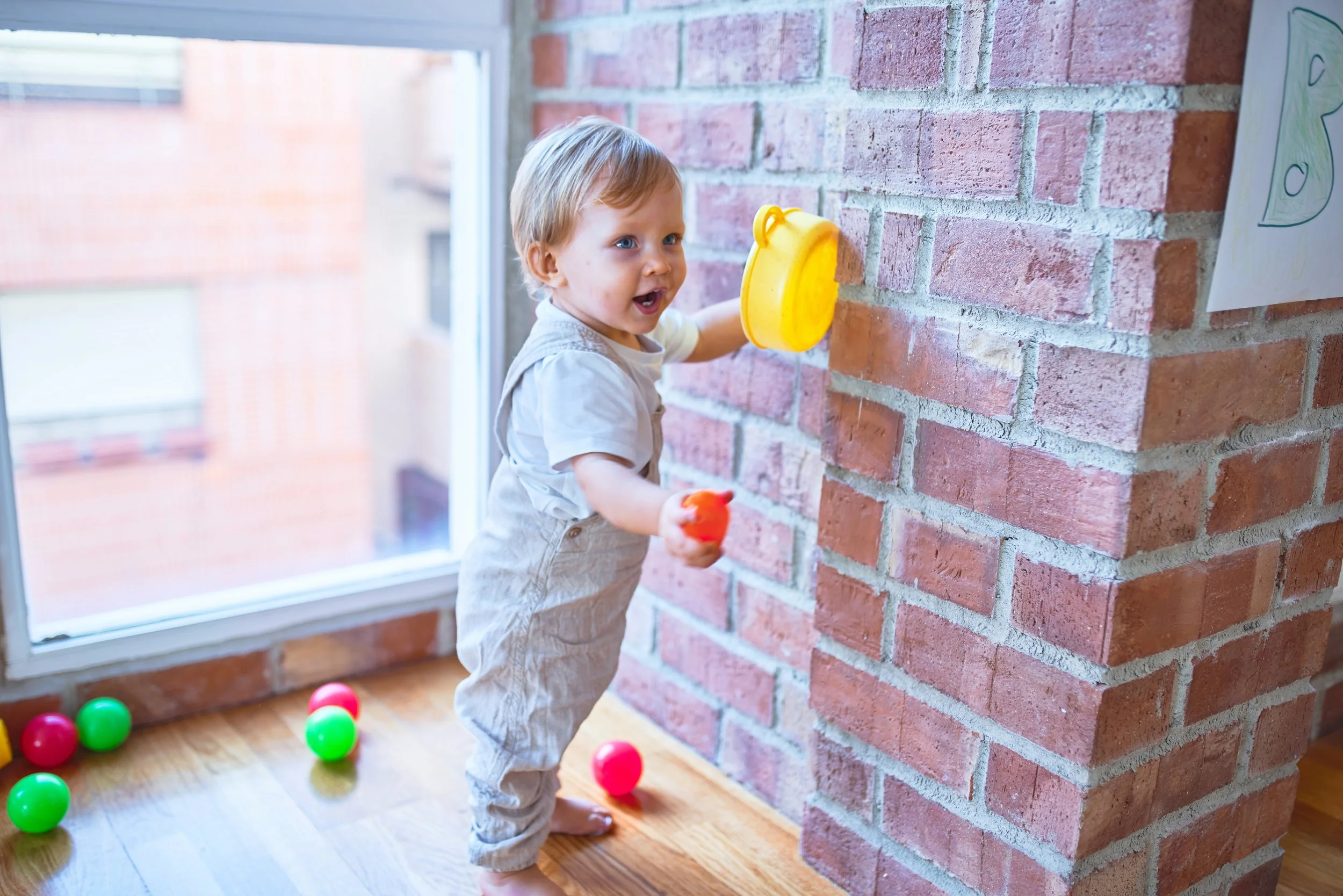How asking less questions encourages kids to talk
Supercharge your speech practice with comments
How often do you ask your child a question? How often do they respond to the questions that you ask? Really think about it - Chances are that you ask many more questions than your child actually answers.
If you realize you’re asking way more questions than you realize, it doesn’t mean you’re doing a bad job! I don’t think I’ve ever met a speech therapist or mom who doesn’t catch themselves asking tons questions when playing with little kids. We’re used to asking questions when we talk to adults, and when we play with little kids our conversation might sound something like this:
“Where are we going to put the blocks? Are you going to build a tower? Did you knock it down?”
At this stage of development, it is better to talk aloud about what you're doing while you do it rather than asking questions. Remember, your child is still learning the meaning of many new words and how to combine them to communicate.
Talking about what you or they are doing instead of asking about it gives your child many more opportunities to learn from and imitate the way you speak.
So when you’re playing with blocks, your toddler is more likely to learn new words if your say,
“Wow! You put the block on top. You’re building a tower. Oh no! you knocked your tower down!”
Tips for encouraging kids to talk by making comments
Tip 1 - Make statements rather than ask questions
When speaking with adults, we typically ask questions to gain information. However, your goal right now is not to gain information from your child — it is to create opportunities for them to learn new words and understand new concepts.
You can do this by training yourself to stop asking questions and make statements instead. For example, instead of asking your child, “What are you doing?” you might say, “I see you playing with your blocks.”
This is a new skill for you, and it may be difficult at first, so start by trying to turn your questions into statements during one activity per day until it becomes a habit. And don’t be hard on yourself if you catch yourself asking questions! It’s great to notice so you can make little changes when your practicing speech therapy at home.
Tip 2 - Avoid asking questions by accident
In English, questions are generally spoken with rising pitch. For example, you can say the word “banana” to comment that the fruit sitting on the table is a banana, but you can also say “Banana?” as if to ask, “Do you want a banana?” When you say a word or sentence to state a fact or make a comment, it sounds different than if you were to ask a question.
Without knowing it, parents often say a word with rising pitch—like a question—when they actually want their child to repeat something that they've said. Children are less likely to repeat something back to you if you say it like a question — this is because they recognize the rising pitch pattern and assume that you are asking a question, even if they don't understand the words that you're saying.
Again, this requires that you be mindful of how you are saying things to your child. If you catch yourself saying something like a question, simply say it again as a statement of fact. For example, instead of “Want to play?”, turn it into the statement “I want to play.”
Tip 3 - Answer any questions that you child does not answer
While you want to reduce the number of questions that you ask, you don’t need to stop asking questions altogether!
When you do ask a question to your child, listen for their response. If they don't answer your question within a few seconds, you should show and tell them the answer.
You can also try changing the way you worded your question to make it easier for your child to answer. For example, if you ask, “What do you want to eat for dinner?” and your child does not respond, you can give them a choice of two answers and then show them their two options. “Do you want tacos or noodles?” In general, it is easier to choose from two options and answer a question either by pointing or saying a single word than it is to answer an open-ended question with many possible responses.
Follow along in this activity to help guide your at home speech practice
This activity is focusing on how to decrease the number of questions your child hears while they’re playing with you. It is common that parents ask questions during play, to ask for ideas, and more commonly to test/check knowledge. Questions like
“What animal is this?
What sound does it make?
Where does it live?
What color is it?”.
Those are all questions testing your child’s knowledge, which they can find exhausting, off putting, or negative if in excess. Occasionally asking questions is ok, but our goal here is to significantly limit how many questions we ask during play. Instead, we’ll focus on turning ideas into statements.
If you’re looking at a book together, common questions are:
What animal is this?
What color is this truck?
Where are they going?
Who is this?
What shape is this?
Instead, turn that same information into a statement, to model what you want your child to be learning about or new words you want to focus on.
What animal is this? ---> I see a cow. This is a cow.
What color is this truck? → It’s a green truck.
Where are they going? → they’re going to the beach!
Who is this? → Here’s the daddy and the grandma.
What shape is this? ---> That’s a big circle! This shape is a circle.
See how the same information is relayed as a statement/sentence for your child to hear and interact with, instead of pushing them to answer your questions.
Now let’s practice some together!
Let’s practice this concept. Can you turn these common questions into statements for a few common play themes? Think of your ideas or print our free download below and write in your statement for each question.
Playing with blocks:
Are you playing with blocks?
_________________________________________
Is your block up high?
________________________________________
What color block is that?
_________________________________________
Playing with a Baby doll:
Is that your baby?
__________________________________________
Is your baby hungry?
__________________________________________
What does your baby want to drink?
__________________________________________
Play kitchen/food:
What are you making?
_________________________________________
Do you want some food?
___________________________________________
What color is that apple?
____________________________________________
Nice work! Now to make this relevant to you and your child, we need you to really focus on how/when/what questions you ask your child during an activity. We need to do an observation. Here are a few observation strategies, one of which you’ll pick and try.
Ask another caregiver or older sibling to listen while you and your child play, and write down any questions you ask your child during the activity.
Record yourself playing with your child (sneaking the camera so your child doesn't focus on it if possible!). Then go back and review the recording after playing, and write down any questions you asked.
While playing, on a small notepad or on your phone, jot down any questions you asked your child.
Any of these observation strategies will work, although #3 is the least conducive to having natural play, because you are splitting your focus to write down the questions as you ask them--and you're also more likely to miss some without someone else to point them out. Pick one observation strategy, and complete it with one or two play activities for at least 5 minutes each. While playing, be as natural as you can be while playing with your child. This is not meant to make you feel embarrassed or nervous, but to call attention to a way you can adjust your play modeling to help your child’s language skills.
Note: In all honesty, I do this exact activity in my speech therapy practice. It is typically not parents’ favorite... they feel uncomfortable and maybe embarrassed as I watch/listen to them so closely. And often surprised as they realize how many questions they really are asking, during what should be a fun time for their child. But once they can increase their own awareness, and then make some changes, most see a change in how their child interacts with them in play, and their child’s language skills.
Play activity one: _______________________________________
Observation strategy used: _______________________________
Play activity two: _______________________________________
Observation strategy used: _______________________________
After playing two activities, with these observation strategies, write down here how many questions you asked.
Play activity one:
How many questions did you ask ? ___________
How many minutes did you play for ? ___________
Play activity two:
How many questions did you ask ? ___________
How many minutes did you play for ? ___________
If you asked more than a couple questions in each play activity, it is likely too many questions. Write down 3-5 questions from your list that you asked during these play activities (Instructions for lines A and B are next!):
1.________________________________________________
A._________________________________________
B. _________________________________________
2.________________________________________________
A._________________________________________
B. ________________________________________
3.________________________________________________
A._________________________________________
B. ________________________________________
4.________________________________________________
A._________________________________________
B. ________________________________________
5.________________________________________________
A._________________________________________
B. ________________________________________
Now go back to parts A and B above, and come up with 2 examples of how you could turn those questions into statements. Remember there are a few examples above if you need ideas.
Fantastic! Now you have successfully practiced turning questions into statements.
The next time you play this activity, try to focus on those statements you wrote down. Consider having the list next to you as a reminder.
Challenge task: After you’ve practiced focusing on statements with your child for a few playtimes, try one of those observation strategies again. Let’s see if you really ARE using less questions! :)
More at home speech therapy strategies:
Focused Stimulation: Repeating words to help toddlers learn them - https://toddlertalk.com/blog/focused-stimulation
Face to Face: The easiest speech therapy strategy - https://toddlertalk.com/blog/getting-face-to-face
Child Led Play: How following your child’s imagination can help them learn! - https://toddlertalk.com/blog/toddler-imagination
© 2020-2025. Stephanie Keffer Hatleli, MS CCC-SLP. All Rights Reserved.
The content offered on ToddlerTalk.com is for informational purposes only. Toddler Talk is not engaged in rendering professional advice, whether medical or otherwise, to individual users or their children or families. No content on this site, regardless of date, should ever be used as a substitute for direct medical advice from your doctor, speech language pathologist, or other health professional. By accessing the content on ToddlerTalk.com, you acknowledge and agree that you are accepting the responsibility for your child’s health and well-being. In return for providing you with information related to home speech and language practice, you waive any claims that you or your child may have as a result of utilizing the content on ToddlerTalk.com.



